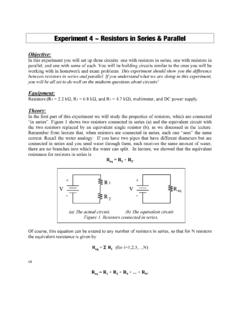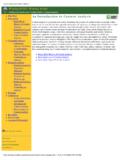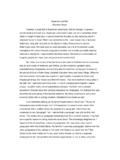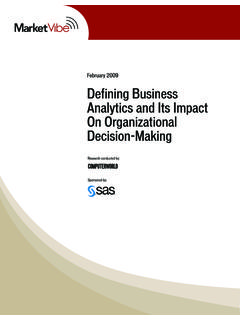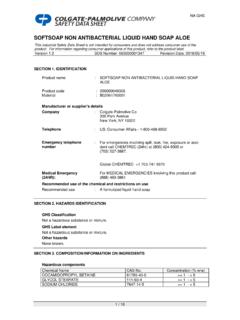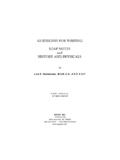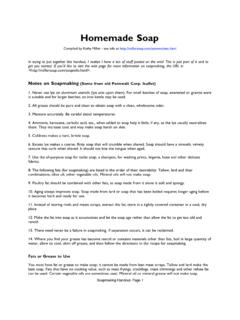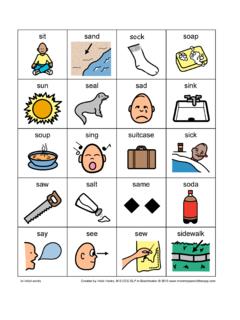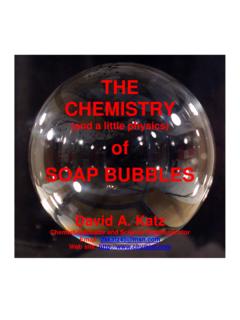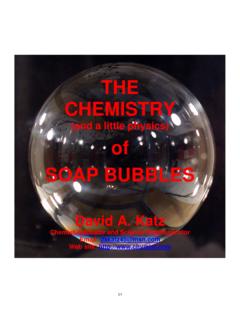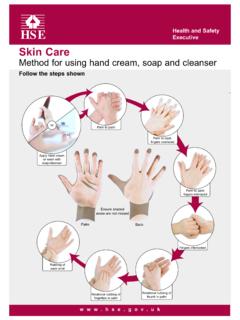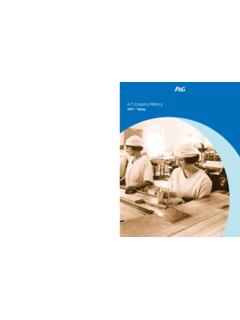Transcription of THE SOAP AND OTHER DETERGENTS …
1 CCA, May 2000, page 1 THE SOAP AND OTHER DETERGENTSMANUFACTURING industry :TRENDS AND CHARACTERISTICSA Report of the Center for Competitive AnalysisMay 2000 This report, prepared by the Center for Competitive Analysis of the University ofMissouri Outreach and Extension (UO/E), provides an overview of the Soap and OtherDetergents manufacturing industry ( soap industry ), Standard Industrial Classification(SIC) code Its primary intended audiences are UO/E, which may considereducational programming designed to assist business owners and workers in the industry ,and economic development policy makers, who can use the information contained hereinto learn more about the industry and develop programs designed to attract or retainbusinesses in this industry . It is by no means intended to be an exhaustive survey of allaspects of the industry . Furthermore, because soaps are part of a broader class ofproducts personal care the report will touch upon some issues that go beyond thenarrow confines of the soap industry .
2 The final section of the report identifies issues thatwill have to be studied in greater depth before educational or developmentalprogramming can be General industry InformationThe soap industry includes companies primarily engaged in making soap, syntheticorganic DETERGENTS , inorganic alkaline DETERGENTS , and crude and refined glycerin fromvegetable and animal fats. In 1997, the latest year for which Economic Census dataare available, this industry had 799 establishments2 nationally. There were roughly29,000 employees in total ($ billion payroll), including 16,749 production workers($576 million payroll). National total value of shipments was $ billion, of which$ billion represented value added. More detailed data are available from OTHER sources,but it is not clear how well the categories by which such data presented correspond tooverall census data for the industry . Assuming a reasonable correspondence, it appearsthat in 1998 laundry detergent sales were $ billion, skin care sales were$ billion, and the sales of personal soaps (bar soap, body wash, and liquid hand soap)totaled $ billion.
3 In the latter category, about 85% of the retail market is split evenlybetween supermarkets and discounters, with drug stores accounting for the remaining15%. Over the past year or so, unit volumes of personal soaps have fallen slightly whiledollar sales have increased slightly. Traditional bar soaps, which are considered a mature category, exhibit very low growth, while newer products (shower gels and body 1 This largely corresponds to the new North American industry Classification System (NAICS) code325611. NAICS 325611 includes the toothpaste portion of SIC 2844 (Toilet Preparations) in addition toSIC category 2841, but virtually all of the new NAICS 325611 (approximately 99%) is from the number of companies is slightly lower; some companies operate multiple , May 2000, page 2washes) and specialty products such as antibacterial and natural soaps still present ampleopportunities for growth.
4 See the Product Market section below for more discussion ofmarket niches and s share of value of shipments in 1997 was approximately $ billion($ billion value added). There were 35 establishments in Missouri, 11 of which had20 or more employees. The industry employed a total of 1,858 persons in Missouri($ million payroll), of which 1,370 were production workers ($ million payroll).According to MarketPlace data for early 2000, a significant majority of Missouri s soapworkers were employed in just a few plants located in the St. Louis and Kansas Cityareas. Most of the small number of establishments found outside the major metropolitanareas are located in southern Missouri. These outstate firms are generally small, withmany employing fewer than 10 from 1992 regarding the overall concentration of the industry reveal that muchof it is controlled by a relatively small number of firms. The four largest firms controlled63% of total industry value added, the top 20 firms controlled 85% and the largest 50firms had 91%.
5 In comparison, the top 50 firms regardless of industry controlled 24% ofthe total value added for manufacturing . But while this industry is clearly moreconcentrated than the overall economy, dominance by a few firms is due to the existenceof a handful of very large producers (Procter & Gamble, Unilever, Dial, and Colgate-Palmolive) whose presence is mainly felt in a few submarkets, such as laundry detergentsand traditional bar soaps. Therefore, although it would be difficult to battle the bigcompanies in such mass market areas, it is quite possible for small companies to competein a number of smaller market segments or The Product Market: Who, What, and Where?Who are they?As is the case in many OTHER markets, the soap and personal products industry is beingdriven to a large extent by the changing age composition of the population, specificallyby the bulge of the baby boom passing through the snake.
6 For example, baby boomershave established anti-aging preparations as the chief benefit of cosmeceuticals (productsaimed at correcting or improving the physiological condition of the skin). Now turningage 50 at the rate of one every 7 seconds, baby boomers have put anti-aging on thetop of the cosmeceutical benefit list. Two-thirds of this group approve of concealingaging signs, which resulted in driving the cosmetic surgery market up 47% in 1999 andspurring an increase in wellness product growth. It is for good reason, then, that babyboomers are the focus of many personal care product manufacturers. They have led thebroad personal care sector of the economy to focus on the potential in aging consumersand their expanding pocketbooks. Growth is occurring in a variety of age-sensitiveproduct markets, from soaps and skin creams to massagers and body fat analysismachines. OTHER trends are discernable as well.
7 Not only are the boomers aging, whichwill drive spa and wellness categories to new heights, but they are entering their peakearning years. As their lives get busier, stress relief products will become more importantto , May 2000, page 3 The group composed of 45-year-old to 54-year-old females is responsible for thehighest amount of sales of body care and bath products in mass stores. And consumerswith an annual household income of $70,000 are spending the most in mass for bathproducts. Furthermore, 40% of female skin care shoppers describe themselves as ecologists, implying that environmental considerations are also becoming moreimportant. Consumers in this category are also more active in personal care markets,spending, for example, $170/year on skin care, or 25% more than the areas within the personal care sector remain unaffected by the changingpopulation composition. Even retailers like Brookstone and Sharper Image expandedtheir interest in branded personal care items.
8 Not only was more retail space dedicated tothe products, but they were often placed in specific spa shops within the store, withdisplays used extensively to merchandise the boomers are not, however, the only group important to the growth of thisindustry. The number of personal care products designed specifically for children isincreasing. Health and beauty aids suppliers are using licensing to tap into the growingspending power of children. Estimates suggest that children between the ages of 4 and 12spend about $ million of their own money each year. Recognizing children s powerto influence parents purchases, suppliers have adorned their products with the images ofcharacters from popular child-oriented movies and television programs. MinnetonkaBrands Inc., has developed scrubbers for its shampoos and body washes that resembleWarner Bros. Looney Toons characters Taz and Tweety. Marketers of kids personalcare products that are not licensed are more likely to utilize advertising or are they buying?
9 All of these changes in the age composition and affluence of the population haveimportant ramifications for makers of soap and OTHER personal products. Companiesmaking more traditional products must carefully review their marketing and otherbusiness strategies in order to adapt to the transformed market. The changes also createbetter opportunities for new companies to enter particular market segments. The massbath and body care category has made recent introductions reflective of several trendsthat department stores, salons, and specialty boutiques have been offering for years. Thedemand for space, which is increasing as a result of product innovation, is causing somecompanies to replace older well-known products with newer ones that contain product activity and the increasing popularity of the bath and body markethelped sales of bar and liquid soap increase last year. A growing perception amongconsumers that they must deal with problem skin and rising levels of concern aboutgerms are helping drive sales of personal soap.
10 Although traditional brands such as Dove,Dial, and Irish Spring still hold the largest portion of the toilet soap market, smallerspecialty soap companies are increasing their market shares. And while the bigger playerssuch as Colgate-Palmolive, Unilever, and Procter & Gamble slug it out in segments suchas antibacterial soaps, smaller companies are reaping the rewards by focusing onspecialty soaps. Consumers want a soap that fits their particular needs and specialtysoaps, often made with natural ingredients (see below), fit the , May 2000, page 4 Bar soap sales accounted for of dollar sales for bath and hand soaps in 1998,making bar soap by far the largest segment in the hand and bath soap category. Whileliquids and gels for personal cleansing have become a fact of life, the traditional soap baris fighting back, initially with translucent soaps and now with transparent products. Anumber of manufacturers of liquids and gels are now also looking at the new clear bars asa way of extending their market coverage.



